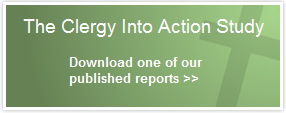Creativity is one of the great gifts pastors and priests can bring to the congregations and other organizations they serve and lead. Fresh ideas can ignite new focus and energy in faith communities. But too much innovation can produce uncertainty and frustration. Finding the balance—that is the challenge for learning how to use creativity effectively.
But—are clergy creative? When we think of creative people, we think of artists, architects, wild-haired musicians or inventors. Are religious leaders creative? If so, how creative are they compared to people in other professions? And how creative are recently ordained clergy—particularly those who have benefited from Transition into Ministry (TiM) and other post-seminary development programs?
The Cree Questionnaire, designed by Melany Baehr (1959) to assess an individual’s creative (or innovative) potential, asks questions about past and present experience in work, school, and other productive settings, and about approaches to work, that indicate creative potential. The Cree has been used as part of a set of professional inventories to help select people for leadership and higher-impact positions in business, government, healthcare, and the nonprofit sector. As the chart shows, people at higher levels in their fields also score higher in creative potential.
We gave the Cree to seasoned Episcopal priests and more recently ordained pastors and priests from many denominations. More seasoned Episcopal priests showed remarkably high creative potential, surpassing almost all groups of professionals and salespeople, matched only by sales managers and executives.
More recently ordained clergy who completed TiM programs showed moderately high creative potential, surpassing base-level professionals, and comparable to mid-level and executive professionals and to base-level sales professionals. Their creative potential was markedly lower than more seasoned clergy (as found among Episcopal priests)—similar to the distance between entry-level professionals and salespeople and their executive counterparts.

Overall, clergy are similar to other mid-level and senior-level leaders in other fields in their creative potential. Newer clergy may feel less permission or freedom to exercise their creative potential as freely as more senior clergy. Hindrances in exercising creativity and leadership can in turn hinder learning and delay development.
Related Articles


